Investigation of Phenolic Resin-Modified Asphalt and Its Mixtures
Abstract
1. Introduction
2. Materials and Preparation
2.1. Asphalt
2.2. PF
2.3. Aggregates
2.4. Preparation of PF-Modified Asphalt
3. Mixture Design and Test Method
3.1. Design and Preparation of PF-Modified Asphalt Mixtures
3.1.1. Design of Aggregate Gradation
3.1.2. Determination of Mixing and Compaction Temperature
3.1.3. Determination of the Optimal Asphalt–Aggregate Ratio and Volumetric Parameters
3.2. Test Method
3.2.1. Mechanical Properties of Asphalt Binders
3.2.2. Mechanical Properties of Asphalt Mixture
4. Results and Discussion
4.1. Empirical Indicator Testing
4.2. Rotational Viscosity Testing
4.3. Temperature Sweep Testing
4.4. MSCR Testing
4.5. Analysis of Low-Temperature Rheological Properties
4.6. PG Grading
4.6.1. High-Temperature Classification
4.6.2. Low-Temperature Classification
4.7. Aging Property
4.8. Marshall Testing
4.9. Water Stability Analysis
4.9.1. Immersion Marshall Testing
4.9.2. Freeze–Thaw Splitting Testing
4.10. FM Analysis
4.11. FT-IR Analysis
5. Conclusions
- (1)
- Adjusting PF content modulates the conventional physical properties of asphalt. Increased PF content decreases penetration and ductility while raising the softening point and viscosity. PF-modified asphalts with 2% and 3% PF showcased the most notable modification effects.
- (2)
- PF contributes to delaying the transition of asphalt from an elastic state to a viscous state, with 3% PF raising the destruction temperature of the base asphalt by 5.6 °C. Owing to PF’s exceptional mechanical properties, it greatly enhances the shear and tensile resistance of the base asphalt.
- (3)
- The elevation of the high-temperature performance grade (PG) from 70 °C for the base asphalt to 76 °C for PF-modified asphalt highlights the potential of PF to extend the operational range of asphalt under high-temperature conditions.
- (4)
- PF does not significantly enhance the low-temperature crack resistance of asphalt binders.
- (5)
- The high viscosity and adhesive properties of PF-modified asphalt reduce porosity within the mixture, enhancing adhesion between different components and improving resistance to high-temperature deformation as well as stripping in the mixture.
- (6)
- The uniform dispersion of PF particles without aggregation contributes to limiting the asphalt flow at high temperatures and inhibiting oxygen penetration.
Author Contributions
Funding
Institutional Review Board Statement
Informed Consent Statement
Data Availability Statement
Conflicts of Interest
References
- Mendonça, A.M.G.D.; Neto, O.D.M.M.; Rodrigues, J.K.G.; Silvani, C.; De Lima, R.K.B. Physicochemical and rheological effects of the incorporation of micronized polyethylene terephthalate in asphalt binder. Pet. Sci. Technol. 2022, 40, 822–838. [Google Scholar] [CrossRef]
- Wu, S. Characterization of ductility of field-aged petroleum asphalt. Pet. Sci. Technol. 2018, 36, 696–703. [Google Scholar] [CrossRef]
- Abdellatif, M.; Peel, H.; Cohn, A.G.; Fuentes, R. Pavement crack detection from hyperspectral images using a novel asphalt crack index. Remote Sens. 2020, 12, 3084. [Google Scholar] [CrossRef]
- Huang, J.; Yan, K.; Wang, M.; Zhang, X. Enhancing rheological and aging performance of matrix asphalt through thermoplastic phenol-formaldehyde resin-based intercalated clay nanocomposites: Mechanisms and effects. Constr. Build. Mater. 2024, 411, 134351. [Google Scholar] [CrossRef]
- Nalbandian, K.M.; Carpio, M.; González, Á. Analysis of the scientific evolution of self-healing asphalt pavements: Toward sustainable road materials. J. Clean. Prod. 2021, 293, 126107. [Google Scholar] [CrossRef]
- BAl-Humeidawi, H.; Chafat, O.H.; Kadhim, H.A. Characterizing the properties of sustainable semi-flexible pavement produced with polymer modified bitumen. Period. Eng. Nat. Sci. 2021, 9, 1064–1072. [Google Scholar]
- Habbouche, J.; Hajj, E.Y.; Sebaaly, P.E.; Piratheepan, M. A critical review of high polymer-modified asphalt binders and mixtures. Int. J. Pavement Eng. 2020, 21, 686–702. [Google Scholar] [CrossRef]
- Polacco, G.; Filippi, S.; Merusi, F.; Stastna, G. A review of the fundamentals of polymer-modified asphalts: Asphalt/polymer interactions and principles of compatibility. Adv. Colloid. Interface Sci. 2015, 224, 72–112. [Google Scholar] [CrossRef]
- Hassanpour-Kasanagh, S.; Ahmedzade, P.; Fainleib, A.M.; Behnood, A. Rheological properties of asphalt binders modified with recycled materials: A comparison with Styrene-Butadiene-Styrene (SBS). Constr. Build. Mater. 2020, 230, 117047. [Google Scholar] [CrossRef]
- Mirzaiyan, D.; Ameri, M.; Amini, A.; Sabouri, M.; Norouzi, A. Evaluation of the performance and temperature susceptibility of gilsonite-and SBS-modified asphalt binders. Constr. Build. Mater. 2019, 207, 679–692. [Google Scholar] [CrossRef]
- Bhat, F.S.; Mir, M.S. A study investigating the influence of nano Al2O3 on the performance of SBS modified asphalt binder. Constr. Build. Mater. 2021, 271, 121499. [Google Scholar] [CrossRef]
- Nanjegowda, V.H.; Biligiri, K.P. Recyclability of rubber in asphalt roadway systems: A review of applied research and advancement in technology. Resour. Conserv. Recycl. 2020, 155, 104655. [Google Scholar] [CrossRef]
- Badughaish, A.; Wang, J.; Hettiarachchi, C.; Xiao, F. A review on the crumb rubber-modified asphalt in the Middle East. J. Mater. Cycles Waste Manag. 2022, 24, 1679–1692. [Google Scholar] [CrossRef]
- Jitsangiam, P.; Nusit, K.; Phenrat, T.; Kumlai, S.; Pra-ai, S. An examination of natural rubber modified asphalt: Effects of rubber latex contents based on macro-and micro-observation analyses. Constr. Build. Mater. 2021, 289, 123158. [Google Scholar] [CrossRef]
- Diab, A.; You, Z.; Adhikari, S.; You, L.; Li, X.; El-Shafie, M. Investigating the mechanisms of rubber, styrene-butadiene-styrene and ethylene-vinyl acetate in asphalt binder based on rheological and distress-related tests. Constr. Build. Mater. 2020, 262, 120744. [Google Scholar] [CrossRef]
- Ahmad, M.; Beddu, S.; Hussain, S.; Manan, A.; Itam, Z.B. Mechanical properties of hot-mix asphalt using waste crumber rubber and phenol formaldehyde polymer. Aims Mater. Sci. 2019, 6, 1164–1175. [Google Scholar] [CrossRef]
- Archibong, F.N.; Orakwe, L.C.; Ogah, O.A.; Mbam, S.O.; Ajah, S.A.; Okechukwu, M.E.; Igberi, C.O.; Okafor, K.J.; Chima, M.O.; Ikelle, I.I. Emerging progress in montmorillonite rubber/polymer nanocomposites: A review. J. Mater. Sci. 2023, 58, 2396–2429. [Google Scholar] [CrossRef]
- Joohari, I.B.; Maniam, S.; Giustozzi, F. Enhancing the Storage Stability of SBS-Plastic Waste Modified Bitumen Using Reactive Elastomeric Terpolymer. Int. J. Pavement Res. Technol. 2023, 16, 304–318. [Google Scholar] [CrossRef]
- Behnood, A.; Gharehveran, M.M. Morphology, rheology, and physical properties of polymer-modified asphalt binders. Eur. Polym. J. 2019, 112, 766–791. [Google Scholar] [CrossRef]
- Islam, S.S.; Singh, S.K.; RN, G.R.; Ravindranath, S.S. Performance deterioration of sbs-modified asphalt mix: Impact of elevated storage temperature and sbs concentration of modified binder. J. Mater. Civ. Eng. 2022, 34, 4021475. [Google Scholar] [CrossRef]
- Xu, X.; Sreeram, A.; Leng, Z.; Yu, J.; Li, R.; Peng, C. Challenges and opportunities in the high-quality rejuvenation of unmodified and SBS modified asphalt mixtures: State of the art. J. Clean. Prod. 2022, 378, 134634. [Google Scholar] [CrossRef]
- Lushinga, N.; Dong, Z.; Cao, L. Evaluating the High-Temperature Properties and Reaction Mechanism of Terminal Blend Rubber/Nano Silica Composite Modified Asphalt Using Activated Rubber. Nanomaterials 2022, 12, 4388. [Google Scholar] [CrossRef]
- Diab, A.; Enieb, M.; Singh, D. Influence of aging on properties of polymer-modified asphalt. Constr. Build. Mater. 2019, 196, 54–65. [Google Scholar] [CrossRef]
- Zhu, J.; Birgisson, B.; Kringos, N. Polymer modification of bitumen: Advances and challenges. Eur. Polym. J. 2014, 54, 18–38. [Google Scholar] [CrossRef]
- Rathore, M.; Haritonovs, V.; Zaumanis, M. Performance evaluation of warm asphalt mixtures containing chemical additive and effect of incorporating high reclaimed asphalt content. Materials 2021, 14, 3793. [Google Scholar] [CrossRef]
- Jiang, H.; Wang, J.; Wu, S.; Yuan, Z.; Hu, Z.; Wu, R.; Liu, Q. The pyrolysis mechanism of phenol formaldehyde resin. Polym. Degrad. Stabil. 2012, 97, 1527–1533. [Google Scholar] [CrossRef]
- Li, C.; Wang, W.; Mu, Y.; Zhang, J.; Zhang, S.; Li, J.; Zhang, W. Structural properties and copolycondensation mechanism of valonea tannin-modified phenol-formaldehyde resin. J. Polym. Environ. 2018, 26, 1297–1309. [Google Scholar] [CrossRef]
- Alonso, M.V.; Oliet, M.; Dominguez, J.C.; Rojo, E.; Rodriguez, F. Thermal degradation of lignin-phenol-formaldehyde and phenol-formaldehyde resol resins: Structural changes, thermal stability, and kinetics. J. Therm. Anal. Calorim. 2011, 105, 349–356. [Google Scholar] [CrossRef]
- Chugh, B.; Thakur, S.; Pani, B.; Murmu, M.; Banerjee, P.; Al-Mohaimeed, A.M.; Ebenso, E.E.; Singh, M.; Singh, J.; Singh, A.K. Investigation of phenol-formaldehyde resins as corrosion impeding agent in acid solution. J. Mol. Liq. 2021, 330, 115649. [Google Scholar] [CrossRef]
- Berdnikova, P.V.; Zhizhina, E.G.; Pai, Z.P. Phenol-Formaldehyde Resins: Properties, Fields of Application, and Methods of Synthesis. Catal. Ind. 2021, 13, 119–124. [Google Scholar] [CrossRef]
- Ravindran, L.; MS, S.; Kumar, S.A.; Thomas, S. A comprehensive review on phenol-formaldehyde resin-based composites and foams. Polym. Compos. 2022, 43, 8602–8621. [Google Scholar] [CrossRef]
- Ming, L.Y.; Feng, C.P.; Siddig, E.A. Effect of phenolic resin on the performance of the styrene-butadiene rubber modified asphalt. Constr. Build. Mater. 2018, 181, 465–473. [Google Scholar] [CrossRef]
- Liu, J.; Wang, S.; Peng, Y.; Zhu, J.; Zhao, W.; Liu, X. Advances in sustainable thermosetting resins: From renewable feedstock to high performance and recyclability. Prog. Polym. Sci. 2021, 113, 101353. [Google Scholar] [CrossRef]
- Yao, H.; Zhang, X.; Shen, L.; Bao, N. Tribological and anticorrosion properties of polyvinyl butyral (PVB) coating reinforced with phenol formaldehyde resin (PF). Prog. Org. Coat. 2021, 158, 106382. [Google Scholar] [CrossRef]
- ASTM D5-06; Standard Test Method for Penetration of Bituminous Materials. ASTM International: West Conshohocken, PA, USA, 2006.
- ASTM D113-17; Standard Test Method for Ductility of Asphalt Materials. ASTM International: West Conshohocken, PA, USA, 2017.
- ASTM D36/D36M-09; Standard Test Method for Softening Point of Bitumen (Ring-and-Ball Apparatus). ASTM International: West Conshohocken, PA, USA, 2009.
- ASTM D4402; Standard Test Method for Viscosity Determination of Asphalt at Elevated Temperatures Using a Rotational Viscometer. ASTM International: West Conshohocken, PA, USA, 2015.
- ASTM C131-06; Standard Test Method for Resistance to Degradation of Small-Size Coarse Aggregate by Abrasion and Impact in the Los Angeles Machine. ASTM International: West Conshohocken, PA, USA, 2006.
- ASTM D5821-13; Standard Test Method for Determining the Percentage of Fractured Particles in Coarse Aggregate. ASTM International: West Conshohocken, PA, USA, 2013.
- ASTM C88-05; Standard Test Method for Soundness of Aggregates by Use of Sodium Sulfate or Magnesium Sulfate. ASTM International: West Conshohocken, PA, USA, 2005.
- ASTM D4792-00; Standard Test Method for Potential Expansion of Aggregates from Hydration Reactions. ASTM International: West Conshohocken, PA, USA, 2000.
- ASTM C136-06; Standard Test Method for Sieve Analysis of Fine and Coarse Aggregates. ASTM International: West Conshohocken, PA, USA, 2006.
- ASTM D1140; Standard Test Methods for Determining the Amount of Material Finer than 75-μm (No. 200) Sieve in Soils by Washing. ASTM International: West Conshohocken, PA, USA, 2017.
- ASTM C127-15; Standard Test Method for Relative Density (Specific Gravity) and Absorption of Coarse Aggregate. ASTM International: West Conshohocken, PA, USA, 2015.
- ASTM D2419-09; Standard Test Method for Sand Equivalent Value of Soils and Fine Aggregate. ASTM International: West Conshohocken, PA, USA, 2009.
- Huang, J.; Liu, Y.; Muhammad, Y.; Li, J.Q.; Ye, Y.; Li, J.; Li, Z.; Pei, R. Effect of glutaraldehyde-chitosan crosslinked graphene oxide on high temperature properties of SBS modified asphalt. Constr. Build. Mater. 2022, 357, 129387. [Google Scholar] [CrossRef]
- ASTM D2726/D2726M-17; Standard Test Method for Bulk Specific Gravity and Density of Non-Absorptive Compacted Asphalt Mixtures. ASTM International: West Conshohocken, PA, USA, 2017.
- Cheng, P.; Li, Y.; Zhang, Z. Effect of Phenolic Resin on the Rheological and Morphological Characteristics of Styrene-Butadiene Rubber-Modified Asphalt. Materials 2020, 13, 5836. [Google Scholar] [CrossRef] [PubMed]
- Yuan, D.; Jiang, W.; Hou, Y.; Xiao, J.; Ling, X.; Xing, C. Fractional derivative viscoelastic response of high-viscosity modified asphalt. Constr. Build. Mater. 2022, 350, 128915. [Google Scholar] [CrossRef]
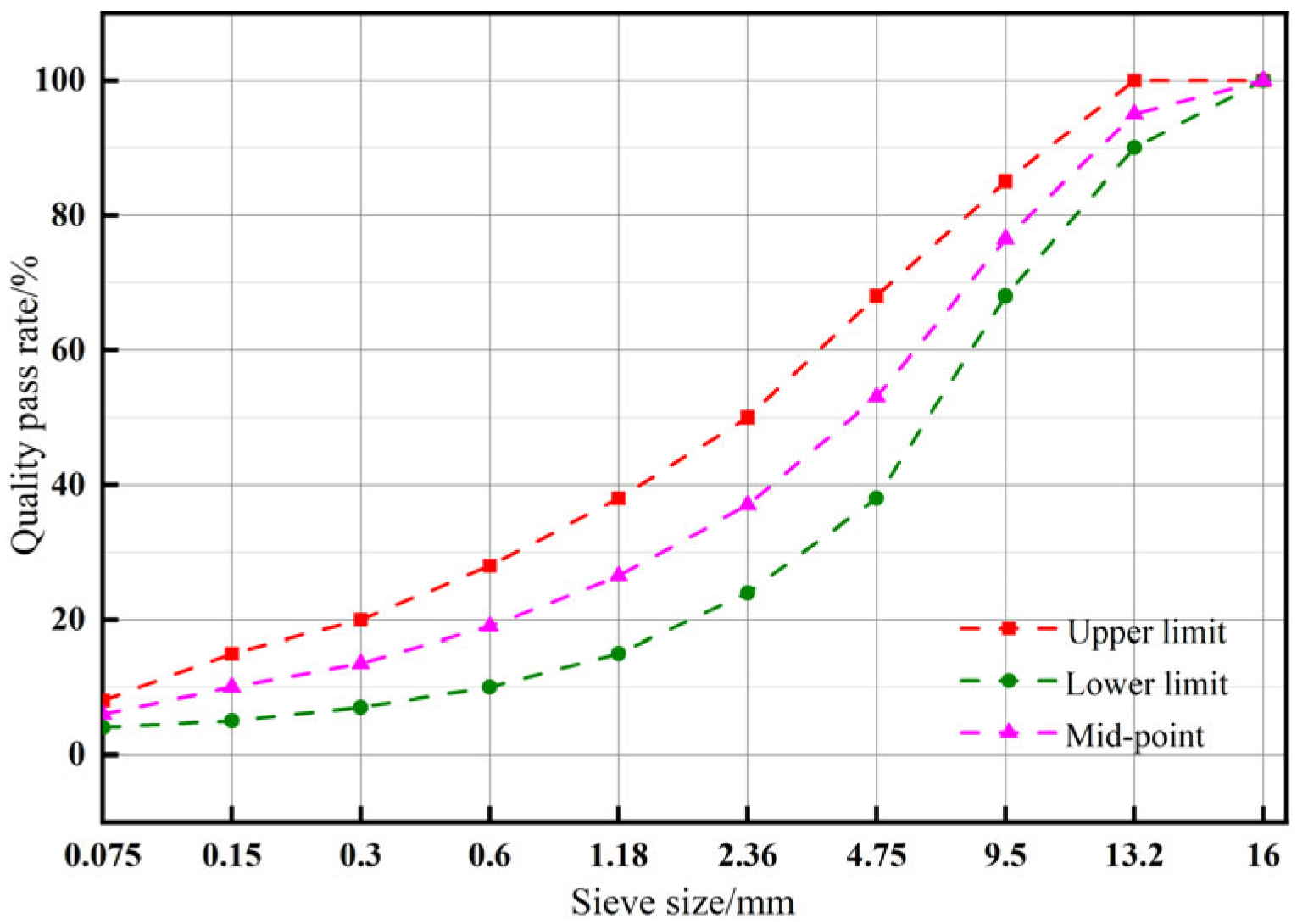
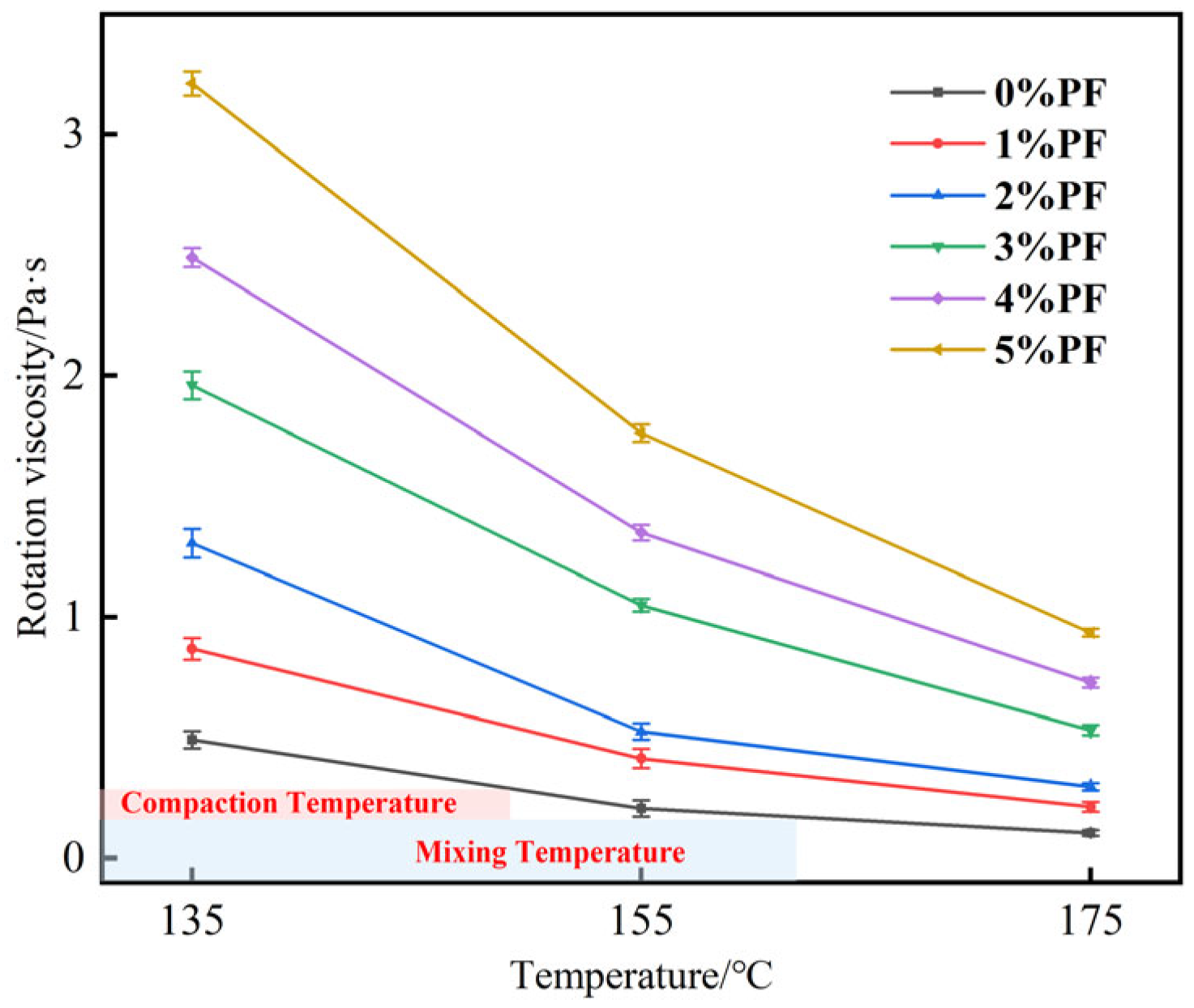
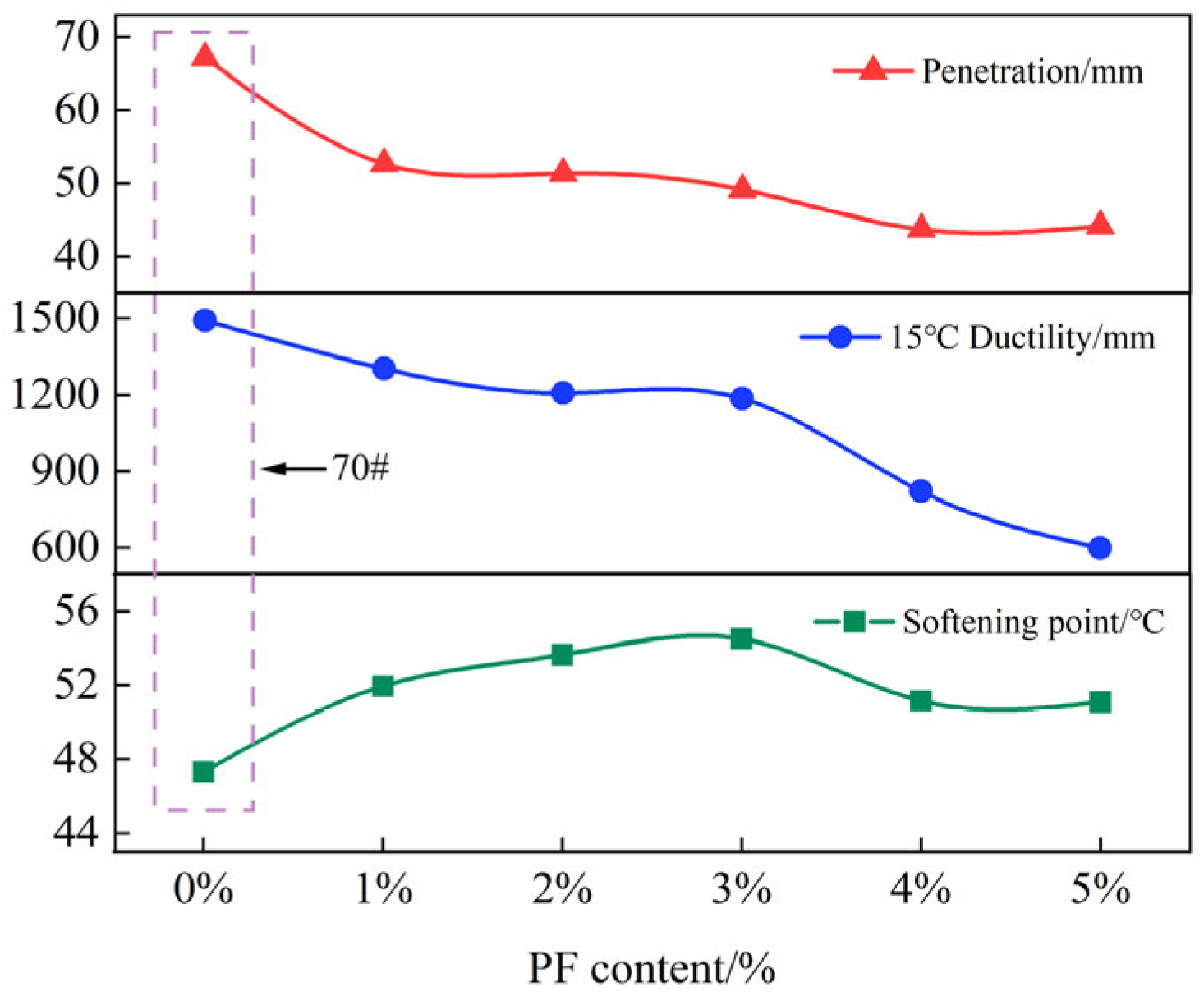


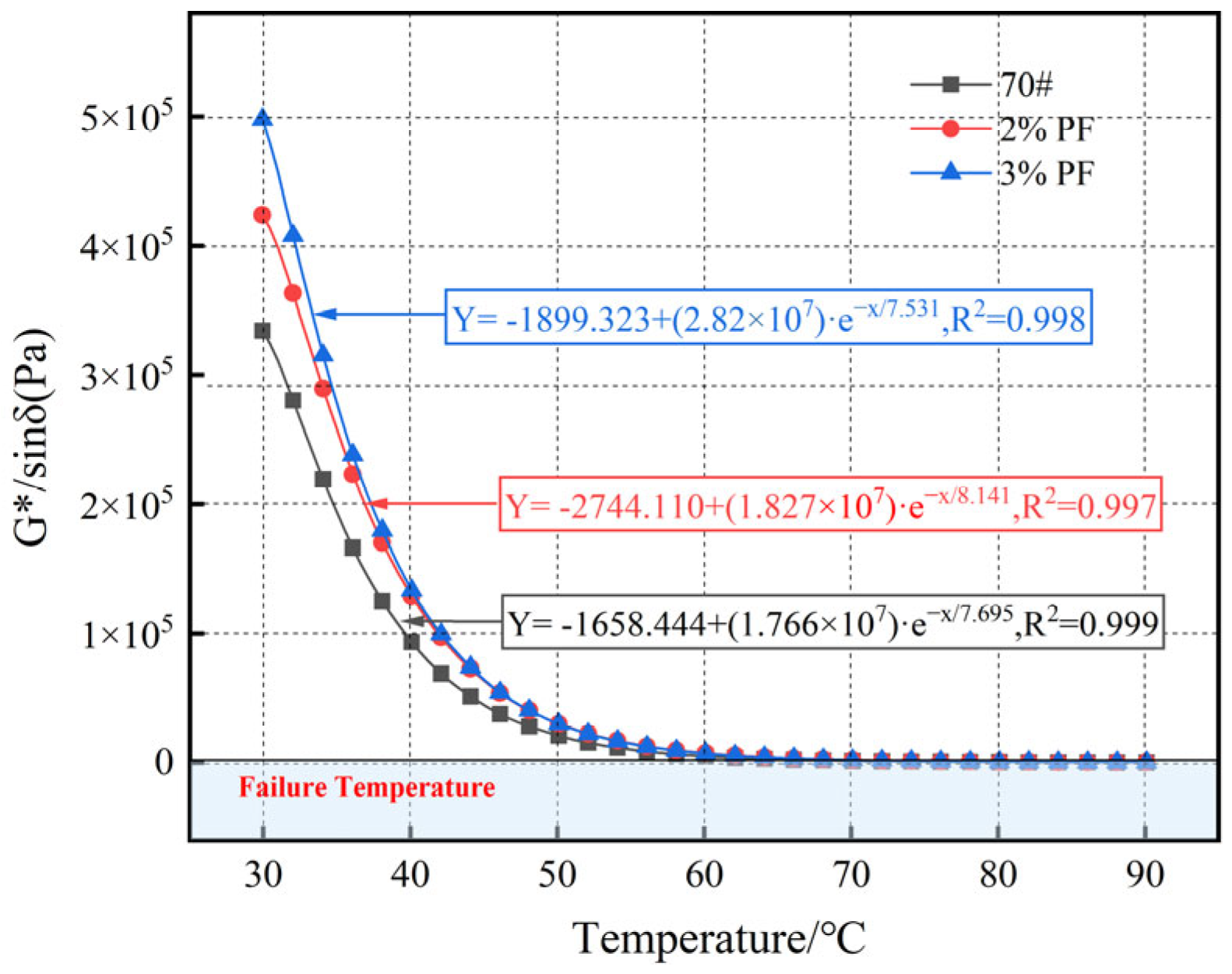
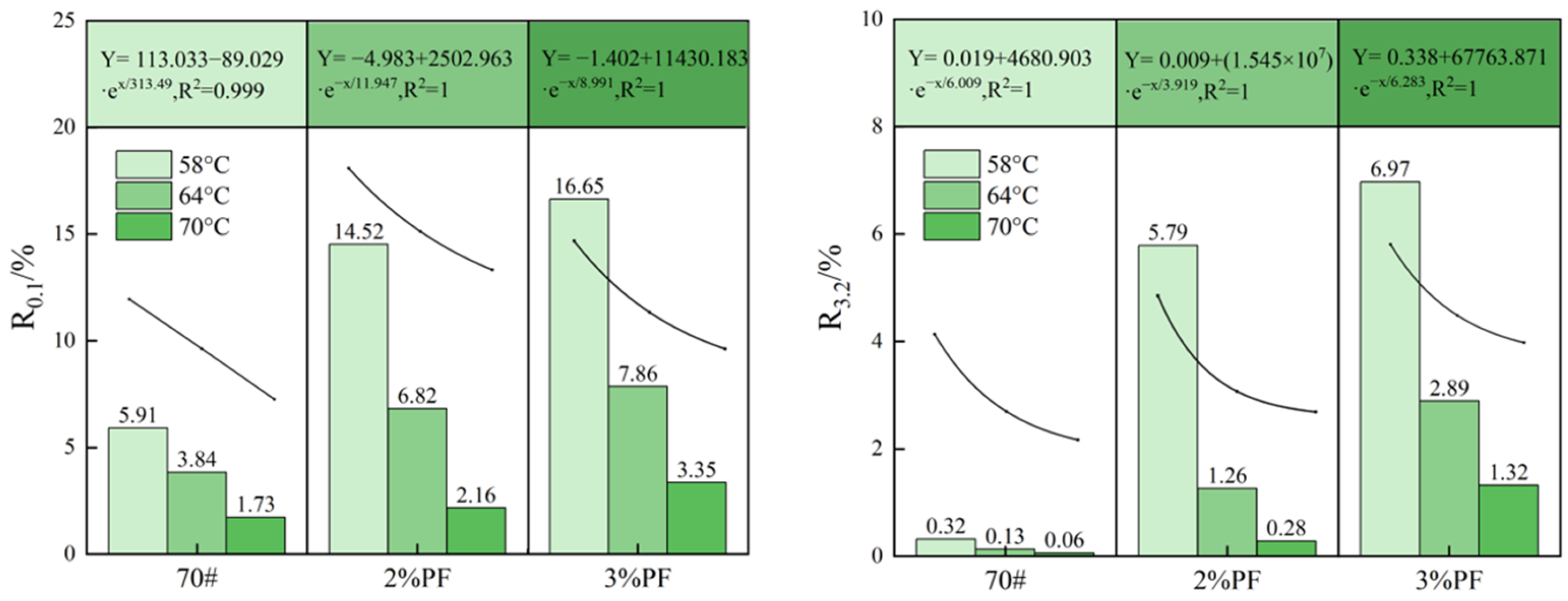


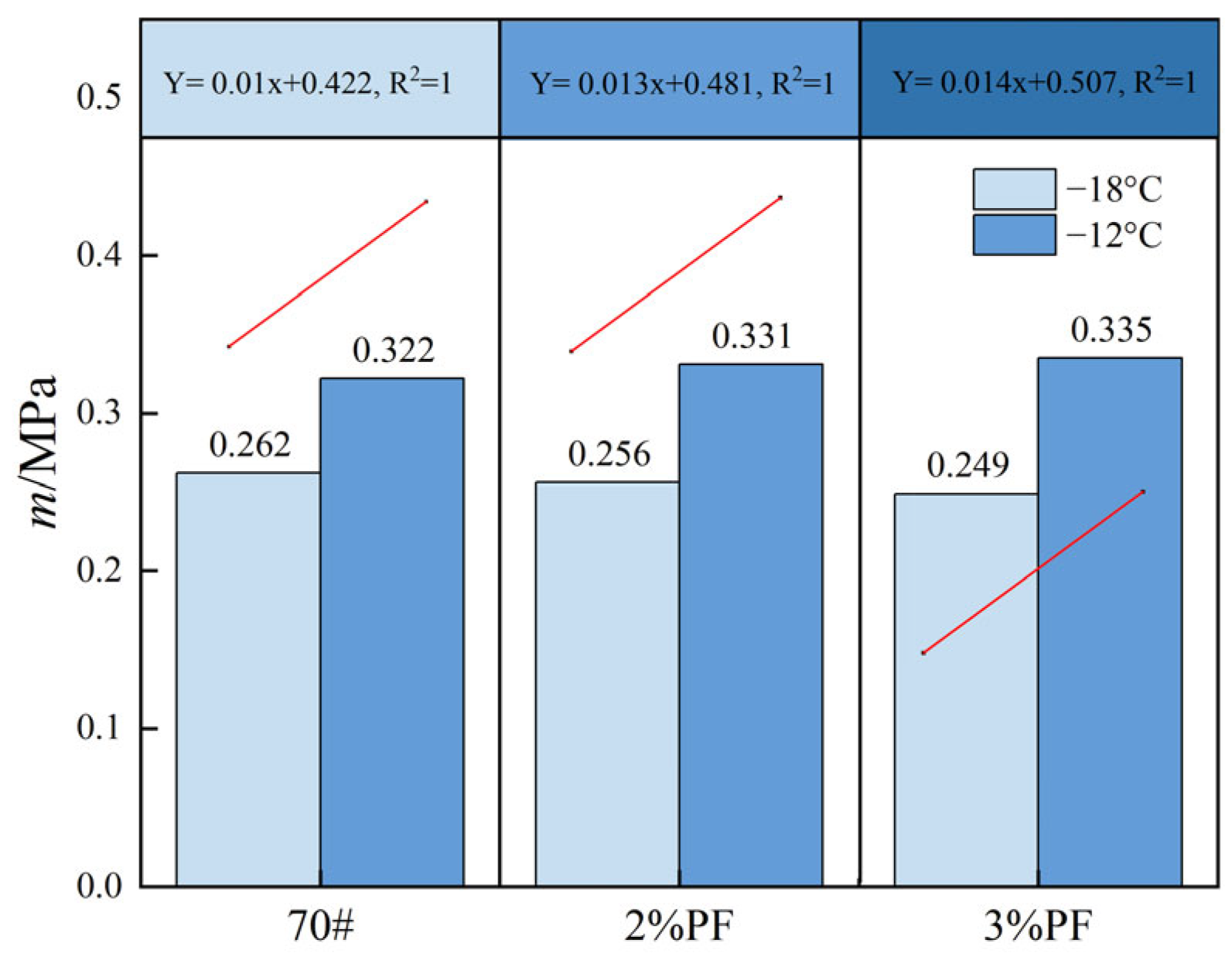

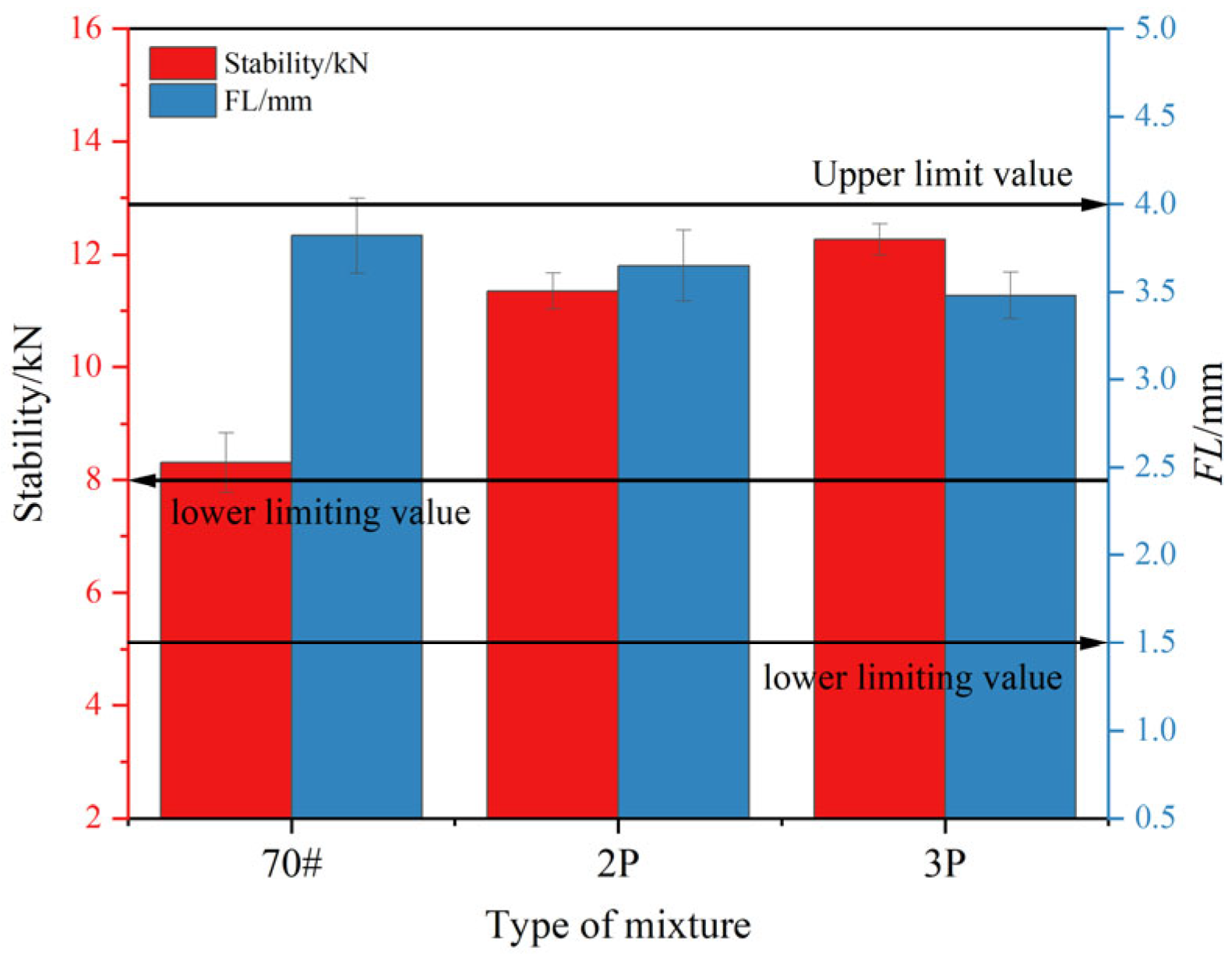

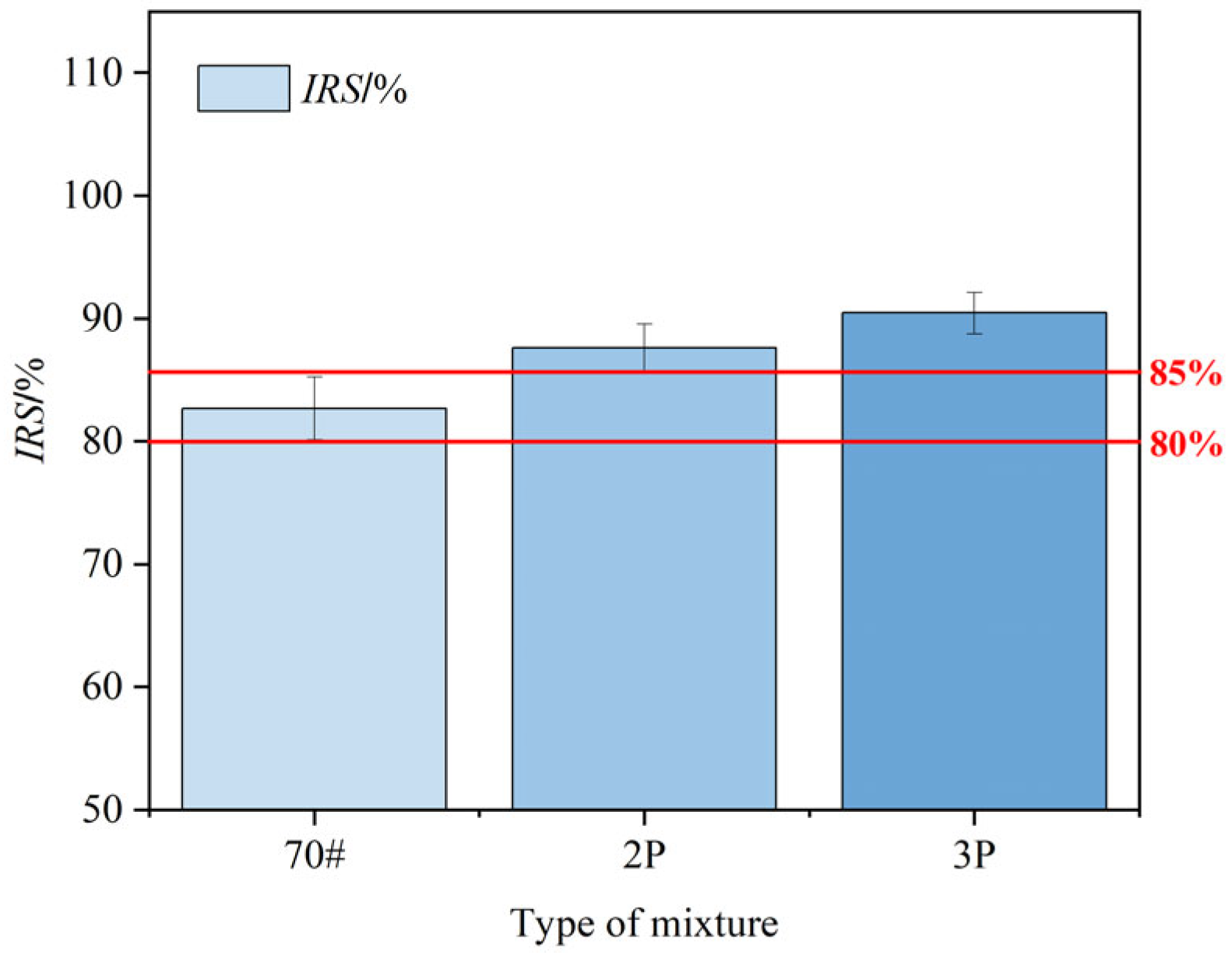

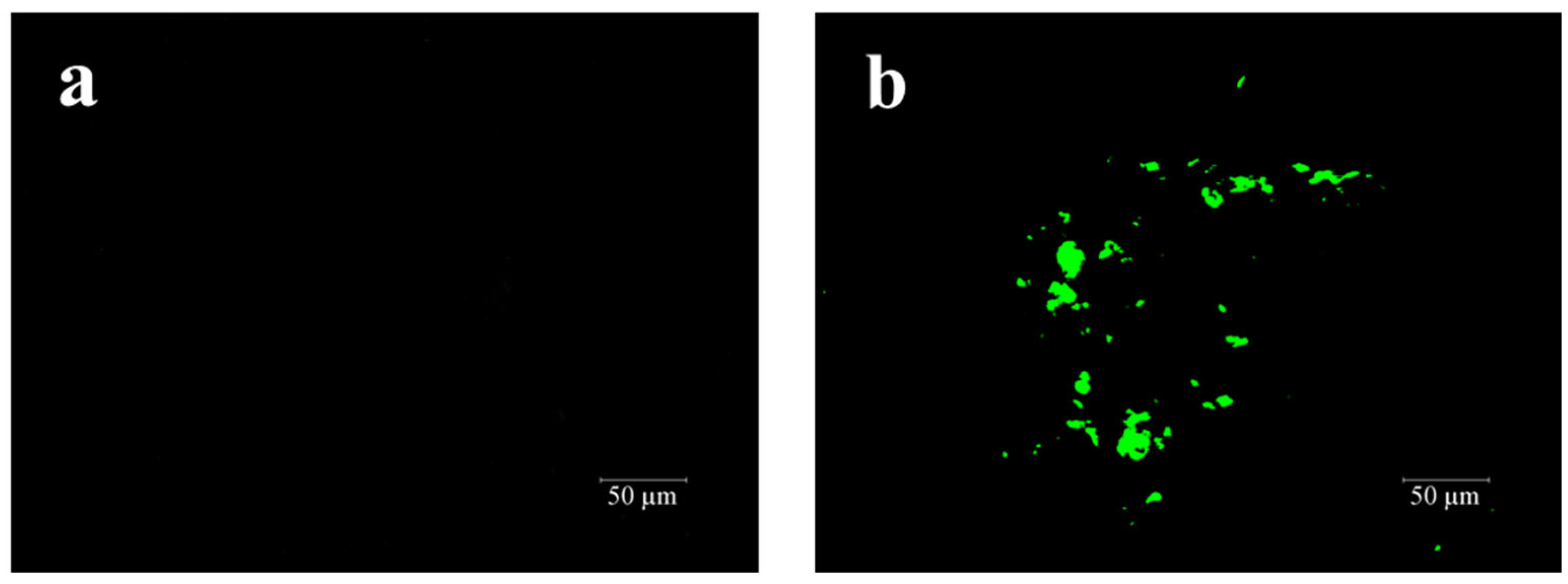
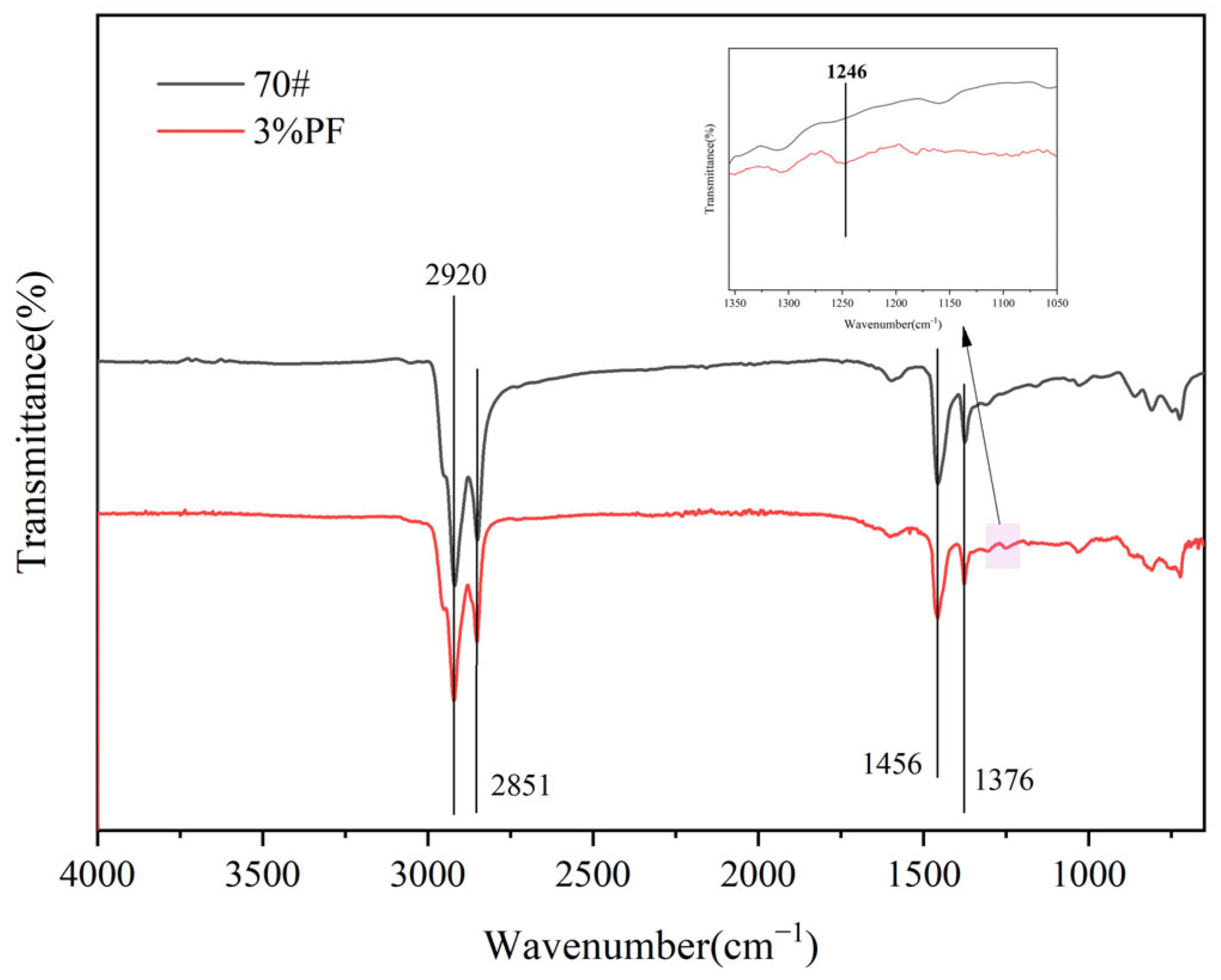
| Index | Test Result | Specification Requirements | Test Method |
|---|---|---|---|
| Penetration (100 g 5 s 25 °C) (0.1 mm) | 67.2 | 60–80 | ASTM D5 [35] |
| Ductility (5 cm/min 15 °C) (cm) | 150 | >100 | ASTM D113 [36] |
| Softening point (°C) | 47.3 | >46 | ASTM D36 [37] |
| Kinematic viscosity (60 °C) (Pa·S) | 110 | ---- | ASTM D4402 [38] |
| Technical Index | Unit | Test Result |
|---|---|---|
| Specific surface area | m2/g | 140 |
| Fineness | mesh | >200 |
| Moisture content | % | <4.0 |
| Flow length | mm | 25~40 |
| Melting point | °C | 85~92 |
| Free phenol content | % | 3.0~4.0 |
| Technical Index | Unit | Test Result | Specification Requirements | Test Method |
|---|---|---|---|---|
| Los Angeles abrasion loss | % | 16.7 | ≤30 | ASTM C131 [39] |
| Crushing value | % | 20.5 | ≤28 | ASTM D5821 [40] |
| Soundness | % | 3.72 | ≤12 | ASTM C88 [41] |
| Soft stone content | % | 1.33 | ≤3.0 | - |
| Needle and flake content | % | 10.13 | ≤15 | ASTM D4792 [42] |
| Particle size > 9.5 mm | % | 9.54 | ≤12 | ASTM C136 [43] |
| Particle size < 9.5 mm | % | 12.66 | ≤18 | ASTM C136 [43] |
| Technical Index | Unit | Test Result | Specification Requirements | Test Method |
|---|---|---|---|---|
| Mud content (<0.075 mm) | % | 2.37 | ≤3 | ASTM D1140 [44] |
| Apparent specific gravity | - | 2.64 | ≥2.50 | ASTM C128 [45] |
| Sand equivalent | % | 77.81 | ≥30 | ASTM D2419 [46] |
| Soundness | % | 4.82 | ≤12 | ASTM C88 |
| Technical Index | Unit | 10–20 Gears | 5–10 Gears | Aggregate Chips |
|---|---|---|---|---|
| Apparent density | t/m3 | 2.71 | 2.786 | 2.635 |
| Water content | % | 0.32 | 0.69 | 0.48 |
| Gross volume relative density | t/m3 | 2.69 | 2.734 | 2.602 |
| Index | 70# | 2% PF | 3% PF | Specification |
|---|---|---|---|---|
| OAC/% | 4.77 | 5.03 | 4.97 | ---- |
| γf | 2.14 | 2.38 | 2.38 | ---- |
| VV/% | 5.52 | 5.22 | 4.78 | 4~6 |
| MS/kN | 8.28 | 11.35 | 12.26 | ≥8 |
| FL/mm | 3.78 | 3.65 | 3.48 | 1.5~4 |
| VMA/% | 17.32 | 15.79 | 15.32 | ≥14 |
| VFA/% | 66.32 | 67.35 | 68.28 | 65~75 |
| Asphalt Type | Critical Temperature/°C |
|---|---|
| 70# | 69.5 |
| 2% PF | 74.2 |
| 3% PF | 75.1 |
| Asphalt State | Test Method | PG Grading Basis |
|---|---|---|
| Not aged | DSR | G*/sinδ ≥ 1.0 kPa |
| Short term aging | DSR | G*/sinδ ≥ 2.2 kPa |
| Asphalt Type | Temperature/°C | G*/sinδ/kPa | Asphalt State | PG | High Temperature PG Level/°C |
|---|---|---|---|---|---|
| 70# | 64 | 2.92 | Before aging | 70 | 70 |
| 70 | 1.31 | ||||
| 70 | 2.89 | After aging | 76 | ||
| 76 | 1.20 | ||||
| 2% PF | 70 | 2.10 | Before aging | 76 | 76 |
| 76 | 1.15 | ||||
| 70 | 1.81 | After aging | 76 | ||
| 76 | 3.85 | ||||
| 3% PF | 70 | 2.08 | Before aging | 76 | 76 |
| 76 | 1.09 | ||||
| 76 | 1.59 | After aging | 76 | ||
| 82 | 0.75 |
| Asphalt State | Test Method | PG Grading Basis |
|---|---|---|
| After long-term aging | BBR | S ≤ 300 MPa, m ≥ 0.3 |
| Asphalt Type | S-Value Critical Temperature/°C | m-Value Critical Temperature/°C | Low Temperature PG Level/°C | Low Temperature PG Continuous Grading/°C |
|---|---|---|---|---|
| 70# | −25.3 | −22.5 | −22 | −22.5 |
| 2% PF | −25.3 | −22.6 | −22 | −22.6 |
| 3% PF | −24.6 | −22.5 | −22 | −22.5 |
Disclaimer/Publisher’s Note: The statements, opinions and data contained in all publications are solely those of the individual author(s) and contributor(s) and not of MDPI and/or the editor(s). MDPI and/or the editor(s) disclaim responsibility for any injury to people or property resulting from any ideas, methods, instructions or products referred to in the content. |
© 2024 by the authors. Licensee MDPI, Basel, Switzerland. This article is an open access article distributed under the terms and conditions of the Creative Commons Attribution (CC BY) license (https://creativecommons.org/licenses/by/4.0/).
Share and Cite
Wang, L.; Wang, L.; Huang, J.; Wu, M.; Yan, K.; Zhang, Z. Investigation of Phenolic Resin-Modified Asphalt and Its Mixtures. Materials 2024, 17, 436. https://doi.org/10.3390/ma17020436
Wang L, Wang L, Huang J, Wu M, Yan K, Zhang Z. Investigation of Phenolic Resin-Modified Asphalt and Its Mixtures. Materials. 2024; 17(2):436. https://doi.org/10.3390/ma17020436
Chicago/Turabian StyleWang, Lieguang, Lei Wang, Junxian Huang, Mingfei Wu, Kezhen Yan, and Zirui Zhang. 2024. "Investigation of Phenolic Resin-Modified Asphalt and Its Mixtures" Materials 17, no. 2: 436. https://doi.org/10.3390/ma17020436
APA StyleWang, L., Wang, L., Huang, J., Wu, M., Yan, K., & Zhang, Z. (2024). Investigation of Phenolic Resin-Modified Asphalt and Its Mixtures. Materials, 17(2), 436. https://doi.org/10.3390/ma17020436






